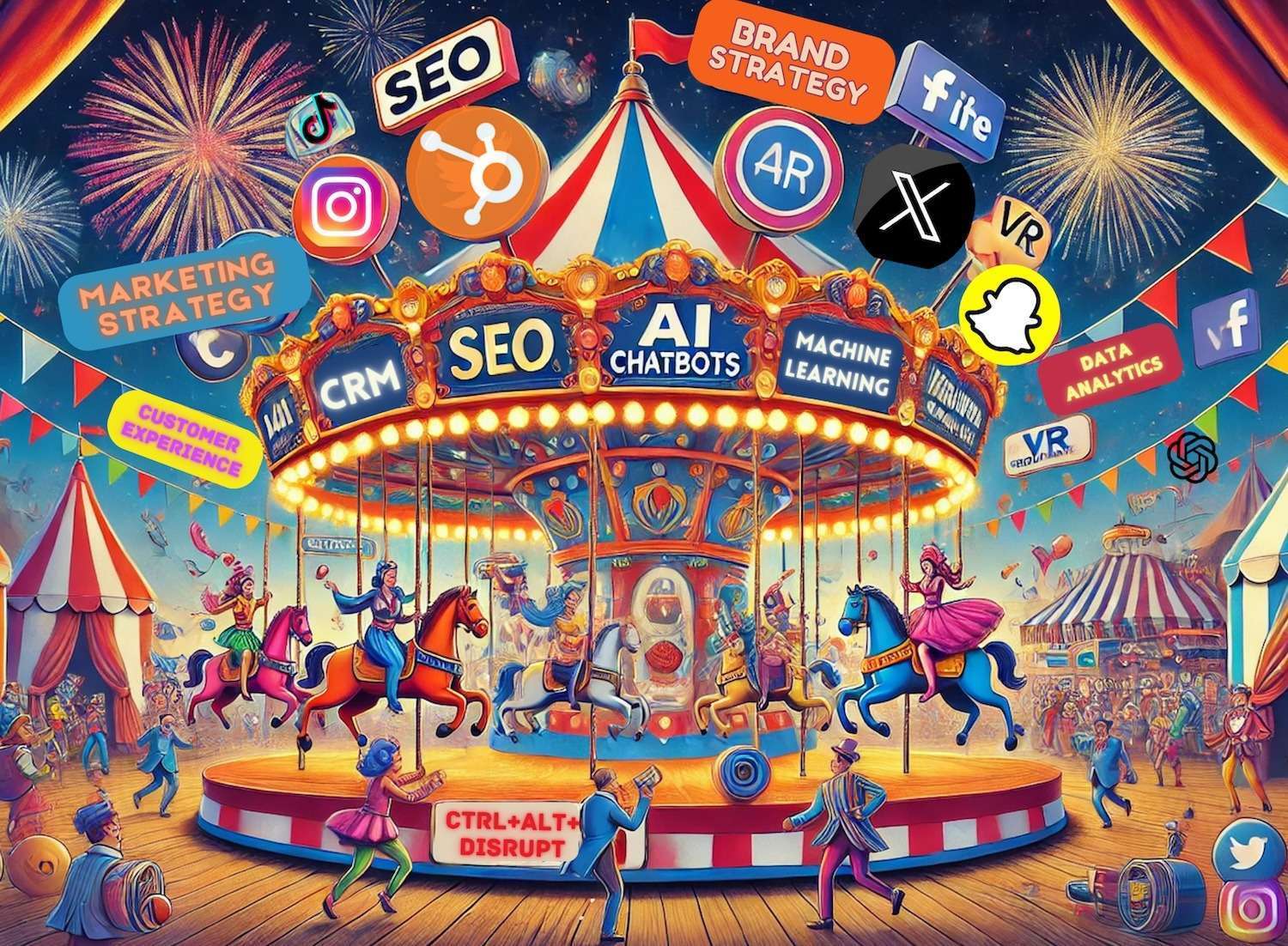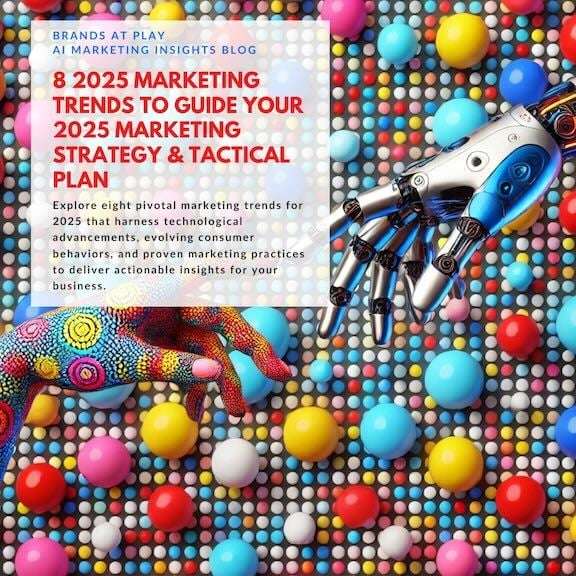Control+Alt+Disrupt: A Rebel's Guide to Brand Strategy for the Bold
The marketing landscape of 2025 demands a fundamental shift in how we approach brand strategy. Artificial intelligence (AI) is no longer a...
7 min read
Stephanie Unterweger : Feb 3, 2025 9:01:31 PM

Uncover the emerging trends and technologies shaping the future of marketing, with clear insights tailored for strategic visionaries.
While mainstream marketing approaches saturate the market, forward-thinking CMOs and marketing leaders are discovering unconventional strategies that deliver exceptional results and set their brands apart. In 2025, it’s not just about leveraging AI or data-driven insights—the market is witnessing a surge of unique approaches that promise to reshape brand engagement and customer experiences. This article explores ten emerging top marketing trends in 2025 backed by statistics and insights from top industry sources, offering fresh perspectives for forward-thinking leaders.
 1. Blockchain for Marketing Transparency and Trust
1. Blockchain for Marketing Transparency and TrustWhile blockchain is best known for revolutionizing finance, its application in marketing is quietly gaining momentum. This technology promises to enhance transparency, reduce ad fraud, and build consumer trust by securely tracking every advertising transaction.
For CMOs, integrating blockchain technology into marketing strategies can serve as a robust differentiator in an era where transparency is paramount.
 2. Neuromarketing and Cognitive Insights
2. Neuromarketing and Cognitive InsightsNeuromarketing leverages neuroscience to understand the subconscious triggers that influence consumer behavior. By examining how the brain responds to marketing stimuli, brands can craft more effective campaigns that resonate on an emotional level.
By incorporating neuromarketing techniques, brands can move beyond surface-level engagement to create deeper, more memorable consumer experiences.
 3. No-Code Marketing Platforms: Democratizing Innovation
3. No-Code Marketing Platforms: Democratizing InnovationThe rise of no-code platforms is revolutionizing how marketing teams deploy digital campaigns. These tools empower marketers without deep technical expertise to build, test, and iterate on innovative campaigns rapidly.
For CMOs aiming to drive agility and innovation, no-code platforms provide a scalable solution to bring creative ideas to life swiftly and cost-effectively.
 4. Virtual Brand Communities and Social Immersion
4. Virtual Brand Communities and Social ImmersionBuilding immersive virtual brand communities is an emerging trend that goes beyond traditional social media engagement. By creating dedicated digital spaces, brands can foster genuine connections and cultivate loyal customer bases.
For strategic marketing leaders, investing in virtual brand communities can lead to richer consumer insights and a more resilient brand identity.
 5. Hyperlocal and Geo-Fenced Marketing 2.0
5. Hyperlocal and Geo-Fenced Marketing 2.0In an age of data saturation, hyperlocal marketing is emerging as a powerful tool for creating highly personalized and contextually relevant campaigns. Advanced geo-fencing techniques enable brands to target consumers based on precise location data.
This approach is particularly effective for retailers and service providers looking to maximize local market penetration and drive real-world results.
 6. Micro-Experiential Augmented Reality (AR)
6. Micro-Experiential Augmented Reality (AR)While augmented reality (AR) has gained popularity in general marketing conversations, micro-experiential AR—integrated seamlessly into social media and mobile applications—is a subtle yet powerful trend that’s reshaping consumer engagement.
By embracing micro-experiential AR, CMOs can offer their audiences novel, shareable experiences that elevate brand perception and drive organic engagement.
 7. Zero-Party Data: Building Trust Through Transparency
7. Zero-Party Data: Building Trust Through TransparencyIn an era marked by strict data privacy regulations and increasing consumer skepticism about data misuse, zero-party data has emerged as a game changer. Zero-party data is information that consumers intentionally and proactively share with brands, such as their preferences, interests, and personal contexts.
For CMOs, zero-party data is not just a trend—it’s an essential component of a forward-thinking, customer-centric marketing strategy.
 8. Immersive Content Marketing: Interactive and Personalized Storytelling
8. Immersive Content Marketing: Interactive and Personalized StorytellingContent marketing remains a cornerstone of brand engagement, but the evolution toward interactive and immersive experiences is redefining its potential. As audiences seek more engaging and personalized content, marketers are innovating beyond static blog posts and traditional videos.
By embracing immersive content marketing, CMOs can create deeper connections with their audiences and drive higher conversion rates.
 9. Micro-Influencer and Ephemeral Social Media Strategies
9. Micro-Influencer and Ephemeral Social Media StrategiesSocial media marketing continues to evolve, and in 2025, authenticity and real-time engagement are taking center stage. Micro-influencers and ephemeral content are emerging as powerful tools to build genuine relationships and drive brand awareness.
For CMOs, these strategies offer an agile approach to social media marketing that emphasizes genuine connection over mass reach.
 10. AI-Driven SEO: Mastering Semantic and Contextual Search
10. AI-Driven SEO: Mastering Semantic and Contextual SearchSearch engine optimization is undergoing a radical transformation as search engines evolve to understand user intent more deeply. Cutting-edge AI and natural language processing (NLP) technologies are reshaping how brands optimize for search, moving beyond traditional keyword strategies.
Embracing AI-driven SEO strategies will enable your brand to dominate search rankings in an increasingly competitive digital ecosystem, driving higher engagement and conversion rates.
The marketing trends of 2025 extend well beyond the well-trodden paths of AI and traditional data analytics. By exploring innovative avenues such as blockchain transparency, neuromarketing, no-code platforms, virtual brand communities, hyperlocal targeting, micro-experiential AR, zero-party data, immersive content marketing, micro-influencer/ephemeral social strategies, and cutting-edge AI-driven SEO, CMOs can unlock new levels of engagement and operational efficiency. These lesser-known trends not only offer fresh insights but also empower brands to build deeper, more authentic connections with their audiences.
For more cutting-edge insights and tailored strategies to future-proof your brand, visit Brands at Play. Our expert team is dedicated to guiding you through these emerging trends with actionable, ROI-focused solutions.
 Ready to disrupt the status quo? Check out our revolutionary book, CONTROL+ALT+DISRUPT: A Rebel’s Guide to Brand Strategy in the Intelligence Era, and learn how to leverage these innovative strategies to elevate your brand in the digital age.
Ready to disrupt the status quo? Check out our revolutionary book, CONTROL+ALT+DISRUPT: A Rebel’s Guide to Brand Strategy in the Intelligence Era, and learn how to leverage these innovative strategies to elevate your brand in the digital age.
Embrace the future of marketing today and position your brand at the forefront of innovation!
Answer:
The top 2025 marketing trends include a blend of innovative strategies and cutting‑edge technologies such as blockchain for marketing transparency, neuromarketing and cognitive insights, no‑code marketing platforms, immersive virtual brand communities, hyperlocal and geo‑fenced marketing, micro‑experiential augmented reality (AR), zero‑party data for personalized engagement, immersive content marketing, micro‑influencer/ephemeral social media strategies, and AI‑driven SEO. These trends provide CMOs with the tools needed to navigate the evolving digital landscape.
Answer:
Digital marketing trends in 2025 are centered on leveraging advanced AI and data analytics to drive personalized customer experiences. Key trends include AI‑driven SEO that focuses on semantic search and real‑time content optimization, immersive content and interactive storytelling, as well as a strategic emphasis on technologies like AR, VR, and blockchain. Marketers are also prioritizing zero‑party data to build trust and deliver hyper‑personalized campaigns.
Answer:
Brands can implement cutting edge marketing strategies in 2025 by embracing innovative technologies and agile approaches. This includes integrating blockchain to enhance transparency and reduce ad fraud, utilizing neuromarketing to create emotionally resonant campaigns, and adopting no‑code platforms for rapid deployment of creative digital experiences. Additionally, investing in AI‑driven SEO, immersive content marketing, and micro‑influencer tactics will enable brands to stay ahead in an increasingly competitive digital market.
Answer:
Zero‑party data is crucial because it is information that consumers voluntarily share with brands, such as their preferences and interests. This data type allows for hyper‑personalization and ensures a higher level of trust and transparency. With growing privacy concerns and stricter regulations like GDPR and CCPA, zero‑party data empowers brands to create more targeted, customer‑centric campaigns while remaining compliant.
Answer:
AI‑driven SEO is a cutting edge marketing strategy that utilizes machine learning and natural language processing (NLP) to understand user intent and optimize content accordingly. This advanced approach goes beyond traditional keyword strategies by focusing on semantic search and real‑time adjustments based on user behavior. By incorporating structured data and optimizing for multi‑modal search (voice, visual, and text), brands can secure higher search rankings and better engagement in the digital landscape.
Answer:
Immersive content marketing is transforming how brands engage with their audiences. By incorporating interactive elements such as quizzes, dynamic infographics, and personalized storytelling, immersive content increases user engagement and brand recall. This trend is a key component of cutting-edge marketing strategies for 2025, as it not only captures attention but also drives higher conversion rates in an increasingly competitive digital environment.

The marketing landscape of 2025 demands a fundamental shift in how we approach brand strategy. Artificial intelligence (AI) is no longer a...

What Is Data-Driven Marketing? Data-driven marketing involves leveraging insights from customer data, market research, and real-time analytics to...
